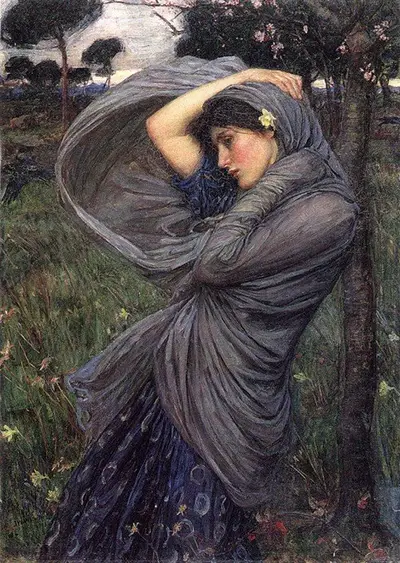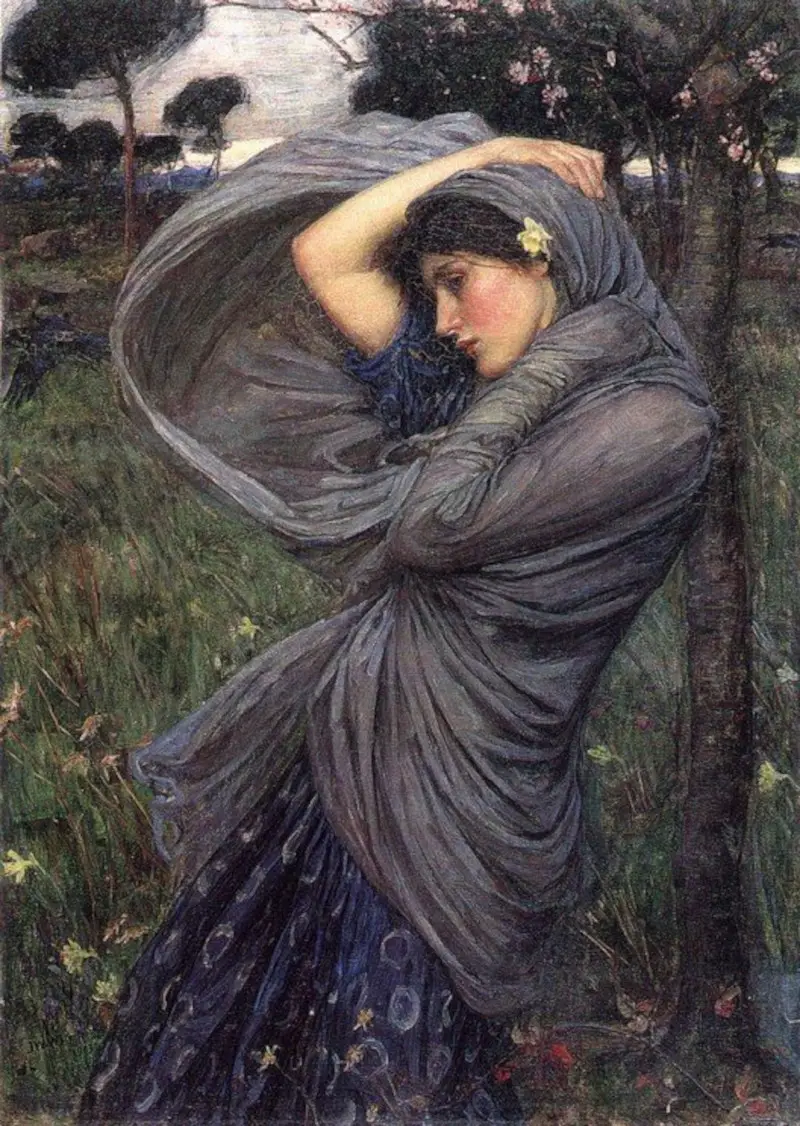Description of Boreas
The striking portrait features a young girl swept by wind as her draperies in slate and blue hues are blown into motion. The painting is set in a spring landscape with pink blossoms and yellow daffodils. The enchanting painting is named after Boreas, the Greek god of the north wind. For more than 90 years, Boreas was lost until it re-emerged during the 1990s when it was put up for sale.
Flowers are dotted around the scene which added to the theme of femininity that sat perfectly with the delicate, pretty models used by the artist. This theme of nature is continued in the background with a series of trees which line the horizon, just behind Boreas' wind-swept cloak.
There has been a resurgence of interest in the artist's career over recent decades, with his style coming back into fashion. This is true of the Pre-Raphaelites more generally, and although Waterhouse was not an official member of the group, his legacy has certainly benefitted too.
Style of the Pre-Raphaelite Brotherhood
Boreas reflects the Pre-Raphaelite style made famous by a group of English painters during the Victoria era. Founded in 1848, the group included William Holman Hunt, John Everett Millais, Dante Gabriel Rossetti and James Collinson.
Art critic Frederic George Stephens, sculptor and poet Thomas Woolner, and writer William Michael Rossetti were also members of the group. The principles of the Pre-Raphaelites were shared by several artists including Waterhouse, such as Marie Spartali Stillman and Ford Madox Brown. By 1853, the group largely disbanded although the term remained in use for works that used dreamy and yearning images of women. The Pre-Raphaelite style rejects mechanistic approaches used by Mannerist artists that followed Raphael and Michelangelo.
The movement was influenced by Romanticism and its themes. Pre-Raphaelites promoted the idea of each artist's individuality. At the same time, they tried to make connections between poetry and art. The movement was also inspired by medieval culture and a bygone spiritual and creative element that was lost in art movements of the Renaissance.
Pre-Raphaelite paintings reembraced the use of vivid poses and elegant visuals, which is evident in Boreas. Like Waterhouse, several artists were influenced by the Pre-Raphaelites. They included John Brett, Edward Burne-Jones, Philip Calderon, Thomas Cooper Gotch, Arthur Hughes, Gustave Moreau, Evelyn De Morgan and Frederic Sandys.
John William Waterhouse borrowed classical styles from the Pre-Raphaelites, which had gone out of style decades earlier. He also embraced concepts and styles made popular by Impressionism, the art movement of his day. The artist was born in Rome to English painters in 1849. He eventually found his way to London, where the family returned in 1854.
Background on the Artist
He often drew sketches of art in the British Museum and the National Gallery. Waterhouse enrolled in the Royal Academy of Art in 1871, where his works were soon displayed at the school's summer exhibitions. His early work focused on classic themes in large canvas paintings, including scenes of daily life and ancient Greek mythology. Waterhouse's art work often depicted women from ancient Greek mythology, such as Boreas. The English painter also used female figures from the Arthurian legend. One of Waterhouse’s most recognised paintings is The Lady of Shalott.
Related Paintings
Three versions of the painting were created in 1888, 1894 and 1916. The version created in 1888 is on display at the Tate Britain in London. It represents a scene from Lord Tennyson’s 1832 poem that shares the same name as the painting. The painting shows Elaine of Astolat, who dies when her love for Lancelot is not returned. In 1894, he also painted The Lady of Shallott looking at Lancelot with a similar yearning style.
Another favourite subject of Waterhouse was Hamlet's Ophelia. He several paintings of Hamlet's Ophelia and other women dying in or near water. Ophelia was a popular subject for Romantic and Classical artists, and Waterhouse's depictions were inspired by similar paintings by Pre-Raphaelites like Dante Gabriel Rossetti and John Everett Millais.
Ophelia was the subject of paintings by Waterhouse in 1988, 1894, and 1909-10. While working on a series of paintings focused on Ophelia, he became ill with cancer and died in 1917.
Large Image of Boreas
This stunning painting is included below in a larger format. Boreas has become known as one of Waterhouse's most famous paintings, and perfectly captures his approach which remained consistent throughout his career. The only real change later on was in how he became more ambitious, taking on larger canvases with more complex detail.


